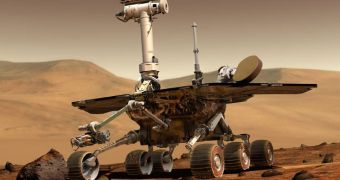Officials at the American space agency are sad to announce that they plan to stop trying to actively establish communications with the Mars Exploration Rover (MER) Spirit. The robot has been stuck in a sandy trap for about two years, and is unresponsive to any radio signals directed at it.
Yesterday, May 24, NASA officials said that there comes a time when engineers need to stop calling and trying to communicate with a spacecraft that is completely unresponsive. The machine made its last contact last year.
Apparently, it did not survive its fourth year on the surface of Mars. If it survived, then it would have automatically gotten the record for the most long-lived mission on the planet. That record lies with its sister spacecraft, Opportunity.
During a conference on Tuesday, NASA officials said that the last commands will be uploaded to Spirit today. Orbiters high above the Martian surface will continue to listen for potential radio signals coming from the explorations robot for a while.
However, neither NASA nor the European Space Agency (ESA) can afford to divert such important resources to this mission for prolonged periods of time, Space reports.
“Planned communications will be done on May 25 but there may be some passive communication attempts after that,” explained Veronica MacGregor, a spokeswoman for NASA.
NASA Jet Propulsion Laboratory (JPL) expert and MER project manager John Callas said that the Mars Reconnaissance Orbiter (MRO), Mars Odyssey and the ESA Mars Express spacecraft will continue their listening campaign until the end of May.
But there is more than a silver lining to all of this, experts added. Spirit functioned for more than 20 times its originally planned mission length, after having arrived on Mars in January 2004, for a three-month stay. It went inactive shortly before it turned seven years old.
The robot also drove about 4.8 miles on the surface of the planet, which is more than 10 times the initial distance the mission had planned. But the most important objective of its mission was to bring Mars to Earth, and that it did with extreme efficiency.
“In addition to the great exploration and the accomplished scientific discovery over its six active years, there's also a 'great intangible' that goes with it: Spirit has made Mars a familiar place,” said Callas.
“Mars is no longer this distant, mysterious location. Human beings now, every day, go to work on Mars […] Mars is now our neighborhood,” the MER program manager added.
“We have developed a strong emotional attachment to both of these rovers. They are just the cutest darn things out in the solar system and I think the public joins us in that,” the NASA official explained.
“They are beautiful, accomplished little proxies out on the surface of Mars and we're quite proud of them and have become quite attached to them,” Callas went on to say in a video conference.
“There's a sadness that we have to say goodbye to Spirit but we have to remember the great accomplishments and the blessings that we have received from having this rover operate for so long, six years,” he added.
“I imagine even Opportunity is a little bit sad to be alone and looking forward to the arrival of MSL,” Callas concluded.

 14 DAY TRIAL //
14 DAY TRIAL //